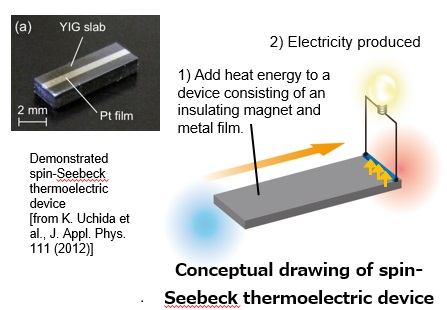Example
Developing a new spin-Seebeck thermoelectric device that enables cheap waste-heat recovery
Background
An enormous amount of waste heat is produced from automotive exhaust or industrial processes etc., and all these are considered affecting the global climate change. One way of reusing the waste heat is to use thermoelectric generators, which can convert the waste heat into electricity. However, the market of thermoelectric devices is still limited very small, mainly because the device cost is too high.
Objectives
Here, we aim at developing a new thermoelectric device employing a new thermoelectric phenomenon termed "spin Seebeck effect" that was found in 2008 in Japan. So far, we have demonstrated that a simple spin-Seebeck thermoelectric device consisting of an oxide magnet and a metal can produce electricity. This device is much simpler than the conventional thermoelectric device and thus has a potential of reducing the device cost, which could in turn result in the practical application to waste heat recovery.
Future prospects
We have found that the thermopower is proportional to the magnetization in the device. Based on this new findings, we try to improve its energy conversion efficiency.


URL
http://www.physics.okayama-u.ac.jp/~adachi/
Representative
